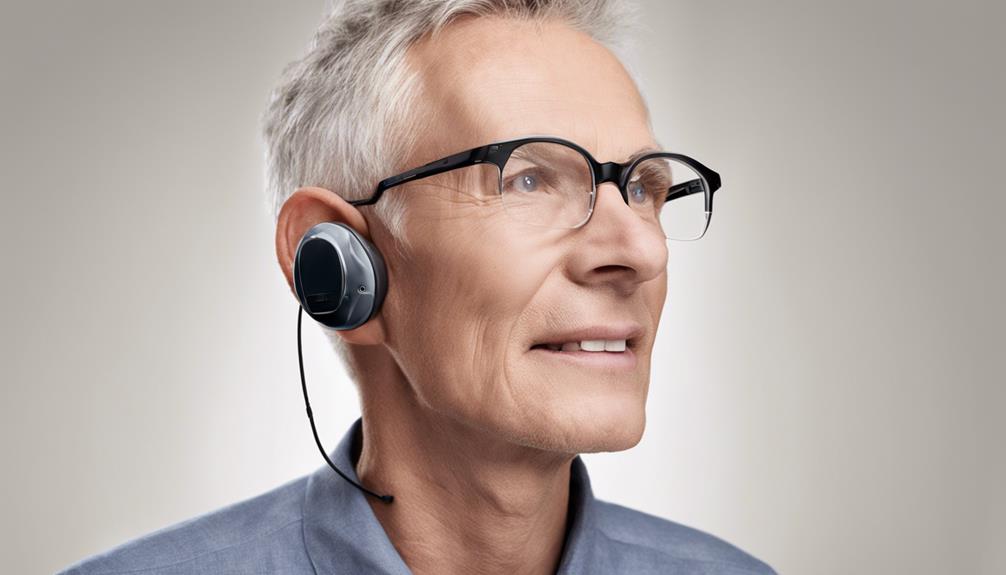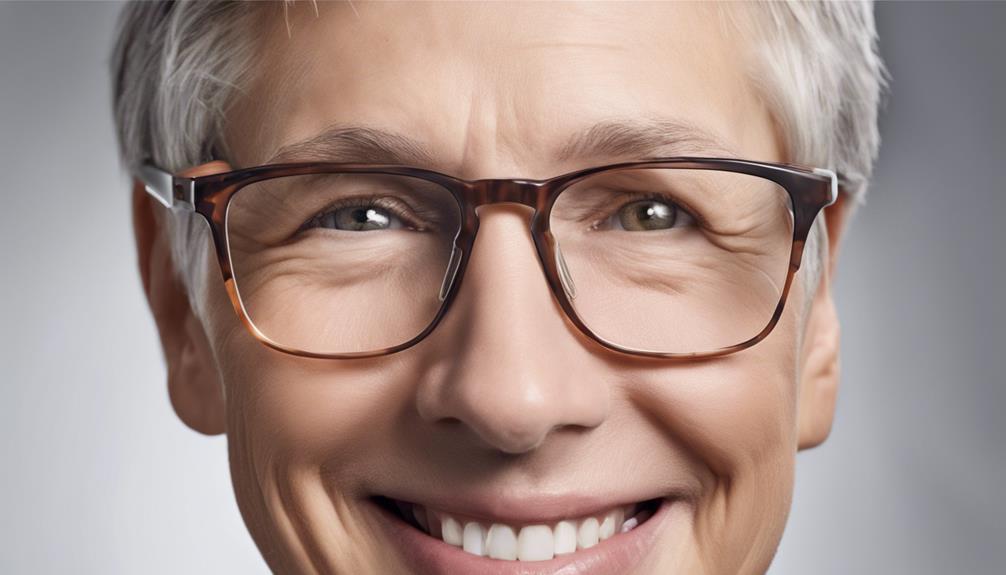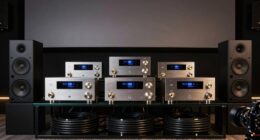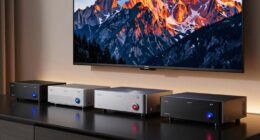Navigating the dual challenge of wearing hearing aids and glasses is like finding the perfect harmony among your accessories.
The intricate dance between these two essential devices can sometimes pose challenges, but fear not, as we have compiled a comprehensive guide to help you seamlessly integrate both into your daily routine.
From practical tips on selecting the right hearing aid model to expert advice on ensuring comfort and functionality, we've got you covered.
Stay tuned to discover the key strategies that will make wearing hearing aids with glasses a hassle-free experience you won't want to miss.
Key Takeaways
- Choose hearing aid model based on comfort, compatibility with glasses, and degree of hearing loss.
- Position BTE devices securely behind the ear for optimal comfort.
- Pair RIC aids with glasses for discreet and comfortable hearing assistance.
- Opt for ITE aids for mild to moderate hearing loss, ensuring minimal interference with glasses.
Choosing the Right Hearing Aid Model
When selecting the appropriate hearing aid model to wear alongside glasses, considering the degree of hearing loss is crucial in determining the most suitable style such as BTE, RIC, ITE, or CIC.
For individuals with moderate to severe hearing loss who wear glasses, BTE hearing aids are often the preferred choice due to their comfort and effectiveness. These behind-the-ear hearing aids sit comfortably behind the ear and offer ample power to address significant hearing loss. This style is popular among users because it accommodates glasses without causing discomfort.
When choosing a hearing aid model, factors like comfort, compatibility with glasses, and the severity of hearing loss should guide the decision-making process. Ensuring that the hearing aid isn't only functional but also comfortable to wear for extended periods is essential for a positive user experience, especially when wearing glasses simultaneously.
Tips for Wearing Behind-the-Ear Devices

To ensure optimal comfort and performance when wearing behind-the-ear devices alongside glasses, implementing a few key tips can enhance the overall experience for individuals with moderate to severe hearing loss.
- Positioning: Properly position the BTE device behind your ear, ensuring it sits comfortably without interfering with the arms of your glasses.
- Fit: Adjust the tubing or earmold to sit securely in your ear canal while allowing enough room for your glasses to rest without pressure.
- Getting Used to Them: Initially, wearing BTE devices alongside glasses may feel slightly uncomfortable. Give yourself time to get used to the sensation as your ears adjust to the new equipment.
Pairing Receiver-in-the-Canal Aids
Pairing Receiver-in-the-Canal Aids enhances the listening experience for individuals with varying degrees of hearing impairment, offering discreet and comfortable solutions. RIC aids, also known as RITE (Receiver in the Ear) Hearing aids, are a popular choice due to their versatility and comfort. They come with thin wire earpieces that make them less noticeable when paired with glasses. Here is a comparison table to help you understand the differences between CIC (Completely-in-the-Canal) hearing aids, BTE (Behind-the-Ear) hearing aids, and RIC aids when wearing them with glasses:
| Feature | CIC Hearing Aids | BTE Hearing Aid | RIC Hearing Aids |
|---|---|---|---|
| Visibility | Minimal | Visible behind the ear | Transparent wire for discreet look |
| Comfort | Can be comfortable due to custom fit | Larger casing might cause discomfort | Smaller casing provides comfort |
| Feedback Reduction | Good | May experience feedback | Reduced feedback due to mic and receiver placement |
Pairing RIC aids with glasses can provide a seamless and comfortable experience for individuals with hearing loss.
Wearing Inside-The-Ear Aids With Glasses

We can explore the compatibility of Inside-The-Ear (ITE) hearing aids with glasses, offering a discreet and comfortable solution for individuals with mild to moderate hearing loss. When considering ITE aids alongside glasses, there are several key points to keep in mind:
- ITE hearing aids are custom-made to fit comfortably inside the ear canal, away from the area where glasses typically rest.
- The compact size of ITE aids ensures minimal interference with glasses, allowing for a snug fit without overlapping.
- ITE aids are designed to be cosmetically appealing, making them a suitable option for those seeking both functionality and discretion.
These custom earmolds used in ITE aids can be tailored to accommodate glasses, providing a personalized and comfortable fit.
Expert Advice for Improved Comfort
How can one ensure optimal comfort when wearing hearing aids with glasses? To enhance comfort, it's crucial to make proper adjustments and pay attention to the positioning of both your glasses and hearing aids. Here are some expert tips to help you achieve a comfortable fit:
| Tip | Description | Benefits |
|---|---|---|
| Position Glasses Correctly | Use glasses with thin wire earpieces to create space for hearing aids. | Prevent discomfort around the ears. |
| Wear Glasses Before Hearing Aids | Always put on your glasses first before inserting or adjusting your hearing aids. | Ensure a seamless fit without interference. |
| Proper Hearing Aid Positioning | Position the hearing aid between the glasses earpiece and outer ear for optimal comfort. | Prevent irritation and ensure a secure fit. |
| Ensure Proper Adjustments | Regularly check and adjust both your glasses and hearing aids to maintain comfort throughout the day. | Avoid discomfort and potential pain from ill-fitting devices. |
Frequently Asked Questions
What Goes on First Glasses or Hearing Aid?
We always put on glasses before our hearing aid to prevent any interference. This way, we can position our glasses carefully to ensure a comfortable fit alongside the hearing aid.
It's crucial to make sure the hearing aid stays secure and close to the ear when wearing glasses. By practicing removing our glasses straight, we can avoid accidentally knocking off the hearing aid.
Adjusting both our glasses and hearing aid will help us achieve a comfortable and secure fit.
Can You Get Hearing Aids That Fit on Glasses?
Yes, some hearing aid models can be custom-made to fit onto glasses, providing a convenient solution for individuals wearing both. Special adapters or accessories are also available to attach hearing aids to glasses frames. Customized fittings ensure a secure and comfortable fit for both hearing aids and glasses.
Consulting with an audiologist or hearing aid specialist can provide recommendations on compatible options. Technology advancements have led to innovative solutions for seamlessly integrating hearing aids with glasses.
How Do You Wear a Hearing Aid and Glasses Mask?
When it comes to juggling hearing aids and glasses with a mask, we've got you covered. Finding the right balance is key.
Position the hearing aid snugly between the mask ear loop and your ear for comfort. Adjust both the mask and hearing aid simultaneously for a secure fit.
Opt for masks with adjustable nose wires to prevent fogging up your glasses. Practice putting on and removing them together for a seamless routine.
How Do You Wear Glasses With a Missing Ear?
When facing the challenge of wearing glasses with a missing ear, we understand the importance of finding a comfortable and secure solution.
Exploring options like glasses with adjustable straps, flexible frames, magnetic attachments, or adhesive pads can offer stability without relying on the ear.
Consulting with an optometrist for personalized advice and trying out different styles will help in discovering the most suitable and comfortable way to wear glasses with a missing ear.
Conclusion
In conclusion, finding the right balance between wearing hearing aids and glasses is crucial for a comfortable experience.
Just like adjusting the focus on a camera lens to capture a clear image, making small adjustments to your devices can help you hear better without sacrificing your vision.
Remember, with a bit of patience and professional guidance, you can seamlessly integrate both aids into your daily routine for improved quality of life.











